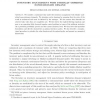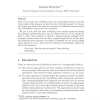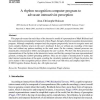997 search results - page 131 / 200 » Completely Lazy Learning |
SIGCSE
2010
ACM
13 years 10 months ago
2010
ACM
An analysis of data from 259 CS1 students is performed to compare the performance of students who were paired by demonstrated ability to that of students who were paired randomly ...
ANOR
2010
13 years 10 months ago
2010
Abstract. We consider a continuous-time model for inventory management with Markov modulated non-stationary demands. We introduce active learning by assuming that the state of the ...
CONNECTION
2006
13 years 10 months ago
2006
Models of associative memory usually have full connectivity or if diluted, random symmetric connectivity. In contrast, biological neural systems have predominantly local, non-symm...
ENTCS
2006
13 years 10 months ago
2006
There are two main ways of defining secrecy of cryptographic protocols. The first version checks if the adversary can learn the value of a secret parameter. In the second version,...
COGSCI
2004
13 years 9 months ago
2004
This paper advocates the main ideas of the interactive model of representation of Mark Bickhard and the assimilation/accommodation framework of Jean Piaget, through a rhythm recog...



